NCERT Exemplar: How do Organisms Reproduce? | Science Class 10 PDF Download
Multiple Choice Questions
Q1: In the list of organisms given below, those that reproduce by the asexual method are
(i) banana
(ii) dog
(iii) yeast
(iv) Amoeba
(a) (ii) and (iv)
(b) (i), (iii), and (iv)
(c) (i) and (iv)
(d) (ii), (iii), and (iv)
Ans: b
Explanation: Dogs reproduce sexually, yeast reproduce by budding, Amoeba reproduce sexually, and cultivated bananas also reproduce asexually.
Q2: In a flower, the parts that produce male and female gametes (germ cells) are
(a) stamen and anther
(b) filament and stigma
(c) anther and ovary
(d) stamen and style
Ans: c
Q3: Which of the following is the correct sequence of events of sexual reproduction in a flower?
(a) pollination, fertilization, seedling, embryo
(b) seedling, embryo, fertilization, pollination
(c) pollination, fertilization, embryo, seedling
(d) embryo, seedling, pollination, fertilization
Ans: c
Explanation: Pollination leads to fertilization after which the embryo is formed. Seedling comes out from the embryo.
Q4: Offspring formed by the asexual method of reproduction have greater similarities among themselves because
(i) asexual reproduction involves only one parent
(ii) asexual reproduction does not involve gametes
(iii) asexual reproduction occurs before sexual reproduction
(iv) Asexual reproduction occurs after sexual reproduction
(a) (i) and (ii)
(b) (i) and (iii)
(c) (ii) and (iv)
(d) (iii) and (iv)
Ans: a
Explanation: Asexual reproduction involves a single parent and there will be no exchange of gametes hence offspring looks similar to their parent.
Q5: Characters transmitted from parents to offspring are present in
(a) cytoplasm
(b) ribosome
(c) Golgi bodies
(d) genes
Ans: d
Q6: Characters that are transmitted from parents to offspring during reproduction show
(a) only similarities with parents
(b) only variations with parents
(c) both similarities and variations with parents
(d) neither similarities nor variations
Ans: c
Q7: A feature of reproduction that is common to Amoeba, Spirogyra, and Yeast is that
(a) they reproduce asexually
(b) they are all unicellular
(c) they reproduce only sexually
(d) they are all multicellular
Ans: a
Explanation: Amoeba reproduce by binary fission, Spirogyra reproduce by fragmentation, and yeast reproduce by budding.
Q8: In Spirogyra, asexual reproduction takes place by
(a) breaking up of filaments into smaller bits
(b) division of a cell into two cells
(c) division of a cell into many cells
(d) formation of young cells from older cells.
Ans: a
Explanation: Spirogyra reproduces by fragmentation. Spirogyra simply breaks up into smaller pieces upon maturation. These pieces or fragments grow into new individuals
Q9: The ability of a cell to divide into several cells during reproduction in Plasmodium is called
(a) budding
(b) reduction division
(c) binary fission
(d) multiple fission
Ans: d
Explanation: Plasmodium divides into many daughter cells by binary multiple fission. In Multiple fission nucleus of the cell divides multiple times by mitosis and then separates to create multiple daughter cells.
Q10: The correct sequence of reproductive stages seen in flowering plants is
(a) gametes, zygotes, embryos, seedlings
(b) zygote, gametes, embryo, seedling
(c) seedling, embryo, zygote, gametes
(d) gametes, embryos, zygotes, seedlings
Ans: a
Explanation: Gametes fuse to form a zygote during fertilization. After fertilization-embryo will be formed which will lead to seedling in plants.
Q11: The number of chromosomes in parents and offsprings of a particular species remains constant due to
(a) doubling of chromosomes after zygote formation
(b) halving of chromosomes during gamete formation
(c) doubling of chromosomes after gamete formation
(d) halving of chromosomes after gamete formation
Ans: b
Explanation: The halving of chromosomes during gamete formation number of chromosomes remains the same as in the somatic cell of an organism. The halving of gametes in chromosomes is called the diploid number of chromosomes.
Q12: In Rhizopus, tubular thread-like structures bearing sporangia at their tips are called
(a) filaments
(b) hyphae
(c) rhizoids
(d) roots
Ans: b
Explanation: Tiny blob-on-a-stick-like structures involved in reproduction are called hyphae. The blobs are called sporangia, which contain cells, or spores, that can eventually develop into new Rhizopus individuals.
Q13: Vegetative propagation refers to the formation of new plants from
(a) stem, roots, and flowers
(b) stem, roots, and leaves
(c) stem, flowers, and fruits
(d) stem, leaves, and flowers
Ans: b
Explanation: Vegetative propagation is a type of asexual reproduction that occurs in plants. In vegetative reproduction, the new plant is produced from vegetative parts of the plants such as roots, stems, leaves, and buds. In vegetative reproduction plants produced are genetically similar enough to the parent plant to have all its characteristics.
Q14: Factors responsible for the rapid spread of bread mold on slices of bread are
(i) large number of spores
(ii) availability of moisture and nutrients in bread
(iii) presence of tubular branched hyphae
(iv) formation of round-shaped sporangia
(a) (i) and (iii)
(b) (ii) and iv)
(c) (i) and (ii)
(d) (iii) and (iv)
Ans: c
Explanation: A large number of spores ensure a few spores survive even in adverse conditions. The availability of moisture and nutrients in the bread provides the necessary environment for the spore to grow into mold.
Q15: Length of the pollen tube depends on the distance between
(a) pollen grain and the upper surface of the stigma
(b) pollen grain on the upper surface of the stigma and ovule
(c) pollen grain in the anther and upper surface of the stigma
(d) the upper surface of the stigma and the lower part of the style
Ans: d
Explanation: The length of the pollen tube ensures pollens reach the stigma to conduct pollination.
Q16: Which of the following statements are true for flowers?
(i) Flowers are always bisexual
(ii) They are the sexual reproductive organs
(iii) They are produced in all groups of plants
(iv) After fertilization, they give rise to fruits
(a) (i) and (iv)
(b) (ii) and (iii)
(c) (i) and (iii)
(d) (ii) and (iv)
Ans: d
Explanation: Flowers are not always bisexual hence statement i) is wrong. Only angiosperms produce flowers hence statement iii) is wrong.
Q17: Which among the following statements is true for unisexual flowers?
(i) They possess both stamen and pistil
(ii) They possess either stamen or pistil
(iii) They exhibit cross-pollination
(iv) Unisexual flowers possessing only stamens cannot produce fruits
(a) (i) and (iv)
(b) (ii), (iii), and (iv)
(c) (iii) and (iv)
(d) (i), (iii), and (iv)
Ans: b
Explanation:
Cross-pollination is necessary for unisexual flowers as they possess either stamen or pistil. Flowers possessing only stamens cannot produce fruits because fruit is a mature ovary.
Q18: Which among the following statements is true for sexual reproduction in flowering plants?
(i) It requires two types of gametes
(ii) Fertilisation is a compulsory event
(iii) It always results in the formation of a zygote
(iv) Offspring formed are clones
(a) (i) and (iv)
(b) (i), (ii), and (iv)
(c) (i), (ii), and (iii)
(d) (i), (ii), and (iv)
Ans: c
Explanation: Off-springs produced from sexual reproduction cannot be clones hence statement iv) is wrong.
Q19: In the given Figure, parts A, B, and C are sequentially (a) cotyledon, plumule, and radicle
(a) cotyledon, plumule, and radicle
(b) plumule, radicle, and cotyledon
(c) plumule, cotyledon, and radicle
(d) radicle, cotyledon, and plumule
Ans: c
Q20: Offspring formed as a result of sexual reproduction exhibit more variations because
(a) sexual reproduction is a lengthy process
(b) genetic material comes from two parents of the same species
(c) genetic material comes from two parents of different species
(d) genetic material comes from many parents
Ans: b
Explanation: In sexual reproduction, the zygote is formed by gametes produced by a male and a female. A male and a female gamete fuse to form a zygote which fertilizes to produce new offspring. Because of the contribution of two parents, offspring incur more variations.
Q21: Reproduction is essential for living organisms to
(a) keep the individual organism alive
(b) fulfill their energy requirement
(c) maintain growth
(d) continue the species generation after generation
Ans: d
Explanation: Reproduction is essential to the lineage of the species whereas other life processes are essential to keep the organism alive.
Q22: During adolescence, several changes occur in the human body. Mark one change associated with sexual maturation in boys
(a) loss of milk teeth
(b) increase in height
(c) cracking of voice
(d) weight gain
Ans: c
Explanation: During adolescence, the following changes occur in boys:-
- Growth of hairs in new parts of the body such as armpits, on the chest, and between thighs near genital organs face, legs, and arms.
- Creaking of voice
- Skin becomes oily and pimples will start appearing
- Occasionally penis will erect especially while dreaming.
Q23: In human females, an event that reflects the onset of the reproductive phase is
(a) growth of body
(b) changes in hair pattern
(c) change in voice
(d) menstruation
Ans: d
Explanation: During adolescence following changes occur in girls:-
- Growth of hairs in new parts of the body such as armpits, between thighs near genital organs thin hairs on the face, legs, and arms.
- Start menstruation
- Skin becomes oily and pimples will start appearing
- Breast size will increase
Q24: In human males, the testes lie in the scrotum, because it helps in the
(a) process of mating
(b) formation of sperm
(c) easy transfer of gametes
(d) all the above
Ans: b
Explanation: Testes lying in the scrotum ensures the temperature of the testes remains lower than the body temperature. This helps in sperm production.
Q.25. Which among the following is not the function of testes at puberty?
(i) formation of germ cells
(ii) secretion of testosterone
(iii) development of the placenta
(iv) secretion of estrogen
(a) (i) and (ii)
(b) (ii) and (iii)
(c) (iii) and (iv)
(d) (i) and (iv)
Ans: c
Explanation: The testis is a male reproductive organ but estrogen is produced in females. The placenta is formed in females during pregnancy.
Q.26. The correct sequence of organs in the male reproductive system for the transport of sperm is
(a) testis → vasdeferens → urethra
(b) testis → ureter → urethra
(c) testis → urethra → ureter
(d) testis → vasdeferens → ureter
Ans: a
Explanation: The testis produces sperm which is transferred into the epididymis through vasdeferns. From vasdeferens sperm is taken to the urethra.
Q.27. Which among the following diseases is not sexually transmitted?
(a) Syphilis
(b) Hepatitis
(c) HIV – AIDS
(d) Gonorrhoea
Ans: b
Explanation: Hepatitis spread through contaminated water and food.
Short Answer Type Questions
Q28: In a bisexual flower despite the young stamens being removed artificially, the flower produces fruit. Provide a suitable explanation for the above situation.
Ans: Removal of stamens of a bisexual flower will not affect pollination as its pistil is intact. Therefore, the formation of fruit will take place as the transfer of pollen grains from the anther of another flower to the stigma of the flower will take place which causes cross-pollination.
Q29: Can you consider cell division as a type of reproduction in unicellular organisms? Give one reason.
Ans: Yes, because cell division in a unicellular organism results in the formation of two daughter cells, which means it produces more individuals of the organisms.
For example, Amoeba is a simple unicellular organism that splits into two daughter cells.
Q30: What is a clone? Why do offspring formed by asexual reproduction exhibit remarkable similarity?
Ans: A clone is the exact genetic replica of another individual. All the offspring formed from a parent through the asexual method of reproduction are the same. The remarkable similarity of asexually produced daughter individuals is due to genetic similarity as they possess exact copies of the DNA of their parent.
Q31: Explain how offspring and parents of organisms reproducing sexually have the same number of chromosomes.
Ans: Because of the halving of the chromosome during gamete formation number of chromosomes remains the same as in a somatic cell of an organism. The halving of gametes in chromosomes is called a diploid number of chromosomes.
Q32: Colonies of yeast fail to multiply in water, but multiply in sugar solution. Give one reason for this.
Ans: Energy is essential for any activity in living organisms. Sugar provides this energy for sustaining all life activities in yeasts. In water, it fails to reproduce because of inadequate energy in its cells. So, colonies of yeast fail to multiply in water but multiply in sugar solution.
Q33: Why does bread mold grow profusely on a moist slice of bread rather than on a dry slice of bread?
Ans: Bread mold requires moisture and nutrients for its growth. A moist slice of bread contains both moisture and nutrients, hence it grows profusely as compared to a dry slice of bread which contains only nutrients but no moisture.
Q34: Give two reasons for the appearance of variations among the progeny formed by sexual reproduction.
Ans: (i) In sexual reproduction, two parents have different sets of characters.
(ii) Gene combinations are different in gametes.
Q35: Would a Planaria cut vertically into two halves regenerate into two individuals? Complete figure D and E by indicating the regenerated regions.
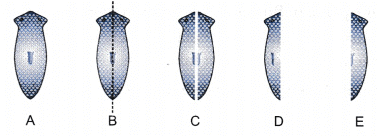 Ans: Yes, a Planaria cut vertically into two halves regenerates into two individuals. The shaded parts in Figures D and E represent the regenerated halves.
Ans: Yes, a Planaria cut vertically into two halves regenerates into two individuals. The shaded parts in Figures D and E represent the regenerated halves.

Q36: From the internet, gather information about the chromosome numbers of five animals and five plants. Correlate the number with the size of the organism and answer the following questions.
(a) Do larger organisms have more number of chromosomes/cells?
(b) Can organisms with fewer chromosomes reproduce more easily than organisms with more number of chromosomes?
(c) The more the number of chromosomes/cells greater the DNA contents. Justify.
Ans: (a) No, there is no correlation between chromosome number and the size of the individual.
(b) No, chromosome number does not affect reproduction. Reproduction depends on environmental factors like nutrient availability, water source, etc.
(c) Yes, since the major component of chromosomes is DNA, if there are more chromosomes in a cell means more DNA.
Q37: In tobacco plants, the male gametes have twenty-four chromosomes. What is the number of chromosomes in the female gamete? What is the number of chromosomes in the zygote?
Ans: The number of chromosomes in the female gamete is 24. The number of chromosomes in the zygote is 48.
Q38: Why cannot fertilization take place in flowers if pollination does not occur?
Ans: Pollination is essential for bringing the male gametes to meet the female gamete. Only after the arrival of pollen grains on the stigma and entry of the pollen tube into the ovary does the male gamete fuse with the female gamete. In the absence of pollination, there will be no male gamete to bring about fertilization.
Q39: Is the chromosome number of zygote, embryonal cells, and adult of a particular organism always constant? How is the constancy maintained in these three stages?
Ans: Yes, the chromosome number of the zygote, embryonal cells, and adult of a particular organism is always constant. The constancy is maintained because the cells in all these three structures undergo only mitotic divisions.
Q40: Where is the zygote located in the flower after fertilization?
Ans: The zygote is located inside the ovule which is present in the ovary part of the pistil.
Q41: Reproduction is linked to the stability of the population of species. Justify the statement.
Ans: In reproduction, DNA passes from one generation to the next. The copying of DNA takes place with consistency but with minor variations and this consistency leads to the stability of species.
Q42: How are general growth and sexual maturation different from each other?
Ans. General growth is the growth of different types of developmental processes in the body like an increase in height, weight gain, and changes in shape and size of the body. Reproductive organs are less active during this phase.
Sexual maturation is a set of changes in the body of an individual at puberty like cracking of voice, new hair patterns, development of breasts in females, etc.
Q43: Trace the path of sperm during ejaculation and mention the gland and its functions associated with the male reproductive system.
Ans: The sperm comes out from the testis into the vas deferens and then passes through the urethra before ejaculation.
The secretions of seminal vesicles and prostate glands provide nutrition to the sperms and also facilitate their transport.
Q44: What changes are observed in the uterus if fertilization does not occur?
Ans: The following changes occur in the uterus if fertilization does not occur
- The extra lining of the Uterus degenerates
- Uterus lining fragments gets discharged through the vagina.
- An unfertilized egg gets discharged
- Menstruation takes place
Q45: What changes are observed in the uterus subsequent to implantation of young embryo?
Ans: The changes observed in the uterus subsequent to implantation of the young embryo are The uterine wall thickens and is richly supplied with blood. The contact region between the embryo and the uterine wall grows into the placenta which provides nourishment and oxygen to the embryo. The waste material of developing embryos is removed by transferring them into the mother’s blood through the placenta.
Q46: What are the benefits of using mechanical barriers during the sexual act?
Ans: The benefits of using mechanical barriers during sexual acts are —
(i) Prevention of pregnancy - Mechanical barriers like condom prevents the sperm from reaching the egg, which is an effective method to avoid pregnancy.
(ii) Non-transmission of Infections - There is no transfer of diseases from the infected person to the non-infected person.
Q47: In the given Figure, label the parts and mention their functions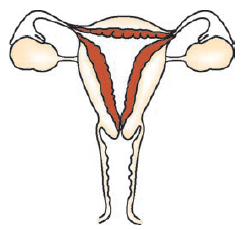
(a) Production of egg
(b) Site of fertilisation
(c) Site of implantation
(d) Entry of the Sperms
Ans: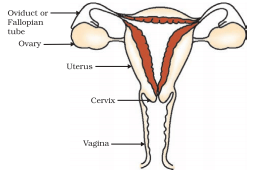
- Ovary
- Oviduct
- Uterus
- Vaginal passage
Q48: What would be the ratio of chromosome number between an egg and its zygote? How is the sperm genetically different from the egg?
Ans: The ratio of chromosome number between an egg and its zygote is 1:2. An Egg is produced through meiosis and therefore, contains half the number of chromosomes of its parent cell whereas a zygote is the product of fertilization between male and female gamete and thus, contains double the number of chromosomes concerning egg.
Sperm is genetically different from the egg in the way that it contains either X or Y chromosome whereas, an egg always contains an X chromosome.
Long Answer Type Questions
Q49: Why are budding, fragmentation, and regeneration all considered asexual types of reproduction? With neat diagrams explain the process of regeneration in Planaria.Ans: In Budding, fragmentation, and regeneration only a single parent is involved and there is no formation of gametes hence they are considered asexual types of reproduction.
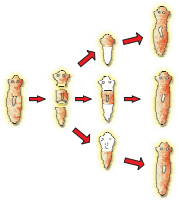 Regeneration of PlanariaHere the body of planaria is cut into pieces and each piece can grow into a new organism. In the figure above the planaria body is cut into 3 pieces which regenerates into 3 individual cells.
Regeneration of PlanariaHere the body of planaria is cut into pieces and each piece can grow into a new organism. In the figure above the planaria body is cut into 3 pieces which regenerates into 3 individual cells.Q50: Write two points of difference between asexual and sexual types of reproduction. Describe why variations are observed in the offspring formed by sexual reproduction.
Ans:
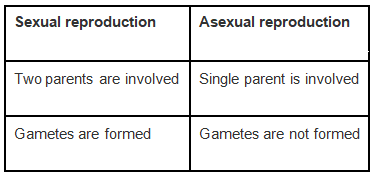
In sexual reproduction, we can find more variations when compared to the asexual mode of reproduction. Following are the reasons for that.
- Gene pools are contributed by two parents
- Crossing over that occurs during meiosis results in more variation
- DNA replication also contributes to the variation
Q51: Distinguish between pollination and fertilization. Mention the site and product of fertilization in a flower. Draw a neat, labeled diagram of a pistil showing pollen tube growth and its entry into the ovule.
Ans:
 The ovary is the site of fertilization and pollination occurs externally
The ovary is the site of fertilization and pollination occurs externally
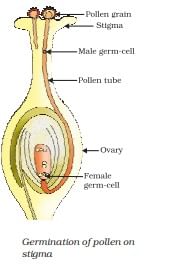
Q52: Distinguish between a gamete and a zygote. Explain their roles in sexual reproduction.
Ans:
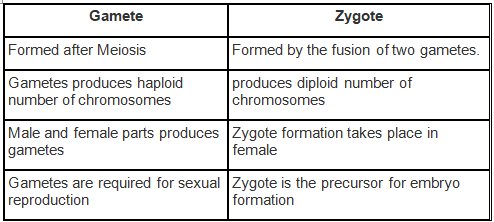
Q53: Draw the diagram of a flower and label the four whorls. Write the names of gamete-producing organs in the flower.
Ans: The ovary produces female gametes. Anthers produce male gametes.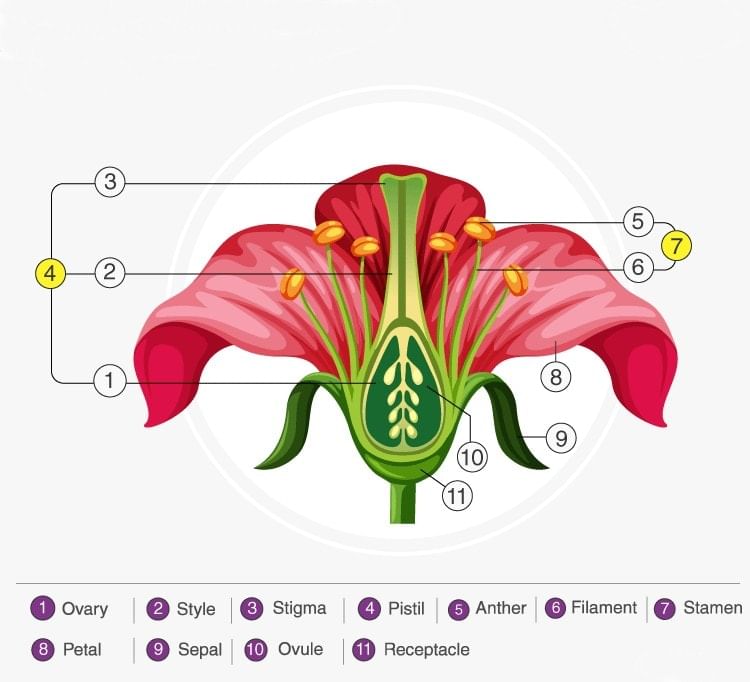
Q54: What is placenta? Mention its role during pregnancy.
Ans: Placenta is a disc which is embedded in the uterine wall. It contains villi on the embryo’s side of the tissue. On the mother’s side are blood spaces, which surround the villi. This provides a large surface area for glucose and oxygen to pass from the mother to the embryo. The embryo gets nutrition from the mother’s blood with the help of the placenta.
The developing embryo will also generate waste substances which can be removed by transferring them into the mother’s blood through the placenta.
Q55: What are various ways to avoid pregnancy? Elaborate on any one method.
Ans: Various ways to avoid pregnancy are given below
Barrier method: In the barrier methods of preventing pregnancy, physical devices such as a diaphragm (or cap) and condoms are used. The diaphragm (or Cap) is used by human females which is put over the cervix. Condoms are used by males.
Q56: How does fertilization take place? Fertilization occurs once a month. Comment.
Ans: Fertilization takes place in the following ways:
(i) The sperm enters through the vaginal passage during sexual intercourse and moves upward.
(ii) Egg released from the ovary reaches the oviduct.
(iii) Sperm encounters egg in the oviduct and fertilization takes place. Fertilization occurs once a month because the egg is released by the female ovary once every month in the middle of the menstrual cycle.
Q57: Reproduction is essentially a phenomenon that is not for the survival of an individual but for the stability of a species. Justify.
Ans. Competition for food and predation are common in nature. If there is no reproduction species would have become extinct. Hence reproduction is linked to the population of a species. New individuals carry the lineage of their parents. More number of organisms counterbalances the mortality that arises due to various factors. Like this reproduction helps in maintaining the stability of a species.
Q58: Describe sexually transmitted diseases and mention the ways to prevent them.
Ans: Diseases that get spread from person to person through sexual means are called sexually transmitted diseases. These include bacterial infections such as gonorrhea and syphilis, and viral infections such as warts and HIV-AIDS.
Below are the ways to prevent sexually transmitted diseases
- Use of condoms or other physical barriers.
- Avoiding sexual contact with unknown partners.
- Avoid sharing towels or underclothing.
- Get a vaccination for hepatitis B.
|
80 videos|569 docs|80 tests
|
FAQs on NCERT Exemplar: How do Organisms Reproduce? - Science Class 10
| 1. What is asexual reproduction and how does it differ from sexual reproduction? |  |
| 2. What are some examples of organisms that reproduce asexually? |  |
| 3. Why is sexual reproduction considered advantageous compared to asexual reproduction? |  |
| 4. How do organisms ensure the continuation of their species through reproduction? |  |
| 5. What role do gametes play in sexual reproduction? |  |

















